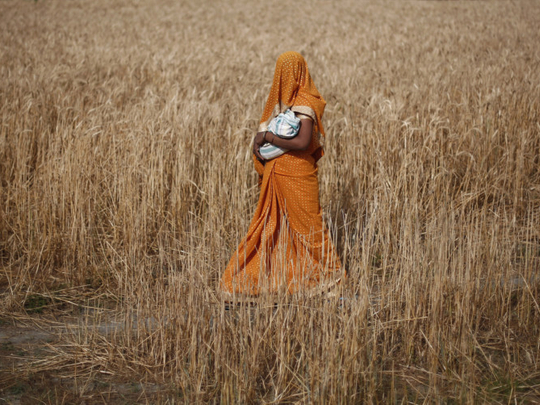
KACHHIDIH, Uttar Pradesh
For decades, Kunta lived in a hut outside Kachhidih village in India’s northern Uttar Pradesh state, enduring the insults of higher-caste villagers who claimed her land — which she did not legally own — for grazing cattle.
She dreamed of owning just a small piece of land for her family who belong to the traditionally low-caste Dalit group.
Six months ago, Kunta got her wish when the state allocated her family and eight others small plots of land a few kilometres away from their old home, after months of delays. Kunta was finally a landowner with her name on the title.
Reached by a dirt track through a field, the land is some distance from the highway. There is one solar lamp post and a hand pump spewing muddy water. Huts cobbled together with straw, mud and plastic offer scant protection from the winter chill.
Yet Kunta, who goes by her first name, is hopeful.
“The place we lived in before was our home for many years, but it did not belong to us. The villagers harassed us and officials asked us for bribes in exchange for titles,” she said.
“This is our land; perhaps we can save some money, plan for our future, for our children. No one can chase us away because we own this land,” she told the Thomson Reuters Foundation.
Landless Dalits like Kunta are at the bottom of India’s age-old social hierarchy, denied land ownership and facing slights and discrimination every day from upper-caste Hindus.
Despite evidence linking landlessness and poverty, and laws to help people secure small plots of land on which to build a home and eke out a living, roughly 56 per cent of India’s rural households — about 100 million families — remain landless.
Most belong to low-caste or indigenous communities.
“The main issue is not non-availability of land, it is corruption and caste,” said Ramesh Sharma, a senior official at rights group Ekta Parishad, which has lobbied the government for years for land for the landless poor.
“Getting land allocated is in itself a challenge, then local revenue officials often ask for bribes to release the titles.
High-caste villagers may object and delay it further because they just don’t want these people to get land,” he said.
Uttar Pradesh is the country’s most populous state, with a population of about 200 million. Dalits make up more than a fifth of the state’s population, but wield little power.
India banned caste-based discrimination in 1955, but centuries-old attitudes persist, and lower-caste groups including Dalits are among the most marginalised communities.
Long delays
But Sarnath Prajapati, a revenue officer of the state, denied that caste is keeping Dalits from getting land, or that there are long delays and corruption in land allocation.
“We have allocated land to the maximum extent possible. It is a priority for the state,” Prajapati said.
“Sometimes, the land that is allocated may be in use by someone. Then we talk to them, and that takes time. Sometimes we have to bring the police to resolve the situation,” he said.
Activist Jignesh Mevani is leading a campaign for land, asking that states give 5 acres (2 hectares) of land to each landless Dalit family so they can earn a living.
The previous federal government had drafted a National Rural Homestead Bill in 2013 to provide plots measuring about 4,400 square metres each to landless families.
But the draft bill was never presented in parliament for approval. Prime Minister Narendra Modi, who came to power in 2014, met Ekta Parishad officials earlier this year and assured them that the bill remained a priority, Sharma said.
A few states including West Bengal, Odisha and Karnataka have drawn up their own laws for land allocation, giving government land and excess private land to the landless.
Homestead plots, measuring just one-tenth of an acre, can deliver “significant economic and nutritional benefits”, with space to grow food, build a home, keep small livestock, and for other livelihood options, according to land advocacy Landesa.
But in India’s fast growing economy, demand for land for industrial and development projects is increasing, and land allocation is beset with challenges, Landesa said.
“Identification of the landless is challenging, available land for distribution is often encroached upon by dominant interests and land management committees are often not functional,” said Shipra Deo, Landesa’s Uttar Pradesh state director.
“Above all, caste is a big factor and very difficult to overcome, as it is so entrenched and so sensitive,” she said.
In Uttar Pradesh’s Jaunpur district, landless Dalits bear the brunt of this ancient caste discrimination. In Kachhidih and Tardih, Dalits are not allowed to work or live close to higher-caste people.
In Kachhidih, one Dalit man was beaten up so badly after his goat entered someone else’s land that he is now bedridden and cannot work, Kunta said.
Land allocated to Kunta and her neighbours was not handed over for months as other villagers argued over the proximity of the land to their fields, said village headman Madhukar Dwivedi.
More than 100 families are still awaiting their titles for land that has been allocated to them, he said.
“In our society, there are good people and bad people. Some people don’t want these people to get land, they just want them to live under them, in their control always,” Dwivedi said.
— Reuters












